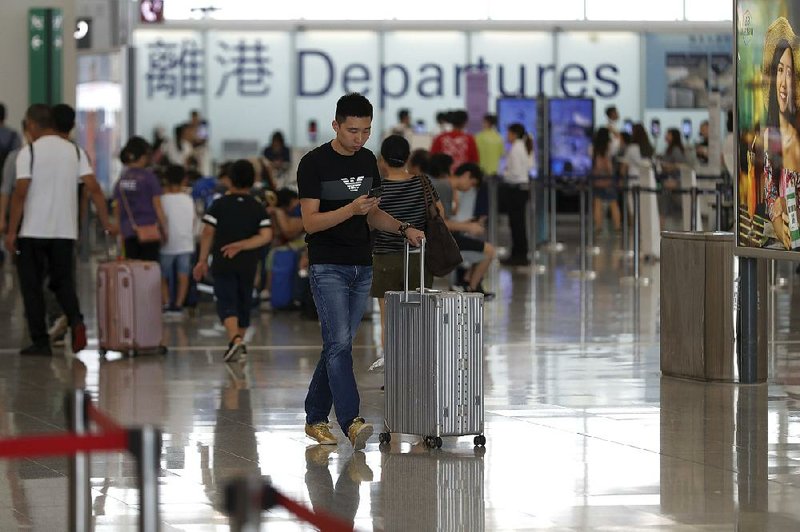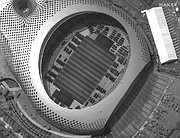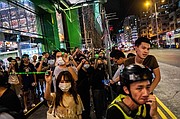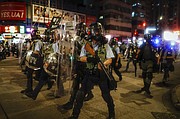HONG KONG -- Flights resumed Wednesday at Hong Kong's airport after two days of disruptions that descended into clashes with police, highlighting the hardening positions of pro-democracy protesters and the authorities in the semiautonomous Chinese city. After nightfall, a new protest outside a police station in the city was dispersed as officers fired tear gas.
Three dozen demonstrators remained camped at the airport arrivals area. They asked travelers and the general public for forgiveness after their blockade turned into chaotic and frenzied violence.
While the movement's supporters still have street protests planned, it's unclear what their next move is or whether they will be able to find new rallying sites to keep the pressure on authorities.
Protesters spread pamphlets and posters on the floor in one section of the terminal but were not impeding travelers. Online, they also circulated letters and promotional materials apologizing for the inconveniences during the past five days of the airport occupation.
[Video not showing up above? Click here to watch » https://www.youtube.com/watch?v=l4UsFGCYp7w]
"It is not our intention to cause delays to your travels and we do not want to cause inconvenience to you," said an emailed statement from a group of protesters. "We ask for your understanding and forgiveness as young people in Hong Kong continue to fight for freedom and democracy."
Another letter also apologized to police. "To police who were affected last night, we will deeply reflect and confront our problems," it read.
In the afternoon, Claudia Mo, an opposition pro-democracy legislator whom Beijing portrays as a mastermind behind the unrest, scolded the protesters for undermining their cause by infuriating travelers and sparking chaotic scenes at the transit hub.
"How would that actually help the Hong Kong cause?" Mo told reporters. "At a time when the protesters have been trying to garner support from the international community, you would be doing the opposite."
The movement was entering a "very, very scary" moment, said Mo, as she floated the possibility that Beijing was engineering the escalation of tensions.
"Could there have been agents provocateurs?" Mo said. "Were we played into a trap? We don't know all the details yet."
Mo later said she did not believe Beijing would send in armed forces to quell the uprising. But after what happened Tuesday, she feared it might.
The airport's management, meanwhile, said it had obtained "an interim injunction to restrain persons from unlawfully and willfully obstructing or interfering" with airport operations. It said an area of the airport had been set aside for demonstrations, but no protests would be allowed outside the designated area.
Additional identification checks were in place, but check-in counters were open and flights appeared to be operating normally. The demonstration resulted in more than 100 flight cancellations Tuesday and about 200 Monday.
Hong Kong police said they arrested five people during clashes at the airport Tuesday night.
Assistant Commissioner of Police Operations Mak Chin-ho said the men, ages 17-28, were arrested for illegal assembly. Two were also charged with assaulting a police officer and possessing weapons as riot police sought to clear the terminal.
In Hong Kong's blue-collar Sham Shui Po neighborhood, police fired tear gas Wednesday night at a group of protesters rallying outside a police station.
The protesters had gathered to burn phony currency and incense as a way to show their opposition to the police during the monthlong Hungry Ghost Festival, when offerings are made to ward off the spirits of ancestors.
More than 700 protesters have been arrested since early June, mostly men in their 20s and 30s, but also some women, teenagers and septuagenarians.
Mak said additional suspects from the airport were expected to be arrested, including those who assaulted an officer after stripping him of his baton and pepper spray, prompting him to draw his gun to fend them off.
Hong Kong law permits life imprisonment for those who commit violent acts or acts that might interfere with flight safety at an airport.
More than 74 million travelers pass through Hong Kong's airport each year, making it "not an appropriate place of protest," Mak said.
FREEDOMS FEARS
The airport disruptions grew from a summer of demonstrations aimed at what many Hong Kong residents see as an increasing erosion of the freedoms they were promised in 1997 when Communist Party-ruled mainland China took over what had been a British colony.
While Hong Kong's crucial travel industry suffers major losses, the city's reputation as a well-regulated center for finance is also taking a hit. At least 21 countries and regions have issued travel safety alerts for their citizens traveling to Hong Kong, saying protests have become more violent and unpredictable.
The demonstrators demand that Hong Kong leader Carrie Lam step down and scrap proposed legislation under which some suspects could be sent to mainland China, where critics say they could face torture and unfair or politically charged trials.
Lam has rejected calls for dialogue, saying the protesters were threatening to push their home into an "abyss."
The Chinese Cabinet's liaison office in Hong Kong said the protesters had "entirely ruptured legal and moral bottom lines" and would face swift and severe repercussions under Hong Kong's legal system.
"Their behavior shows extreme contempt for the law, seriously damages Hong Kong's international image and deeply hurts the feelings of the broad masses of their mainland compatriots," the statement said.
Most of the protesters left the airport Tuesday after riot police tried to enter the terminal, fighting with demonstrators who barricaded entrances with luggage carts. The brief clash led to several injuries.
The violence included protesters beating up at least two men they suspected of being undercover Chinese agents. Airport security appeared unable to control the crowd, and paramedics later took both men away. Police have acknowledged using "decoy" officers, and some protesters over the weekend were seen being arrested by men dressed like demonstrators -- in black and wearing face masks.
Hu Xijin, editor-in-chief of the Global Times, identified one of the men as a journalist at the nationalistic Chinese tabloid.
The protesters apologized that some of them had become "easily agitated and overreacted." On posters, the demonstrators said they have been "riddled with paranoia and rage" after discovering undercover police officers in their ranks.
Earlier this week, the central government in Beijing issued an ominous characterization of the protest movement as something approaching "terrorism" -- a label it routinely applies to nonviolent protests of government policies on the environment or in minority regions such as Xinjiang and Tibet.
Satellite photos show what appear to be armored personnel carriers and other vehicles belonging to the China's paramilitary People's Armed Police parked in a sports complex in the city of Shenzhen, across the border in Hong Kong, in what some have interpreted as a threat from Beijing to use increased force against protesters.
The pictures collected on Monday by Maxar's WorldView show 500 or more vehicles sitting in and around the soccer stadium at the Shenzhen Bay Sports Center.
President Donald Trump tweeted that U.S. intelligence believes that the Chinese government is moving troops to its border with Hong Kong and that, "Everyone should be calm and safe!"
Chinese state media have said only that the Shenzhen exercises had been planned beforehand and were not directly related to the unrest in Hong Kong.
Beijing has been apparently reluctant to send in police or army units from the mainland or to mobilize the People's Liberation Army garrison in Hong Kong to quell the unrest. It's seen as mindful of the devastating effect that would have both on the territory's reputation as a safe and stable place to invest in, and as indication of the Communist Party's failure to win over the hearts and minds of the city's 7.3 million residents, 22 years after the former British colony was handed over to China.
It would also be a shocking reminder of the People's Liberation Army's bloody crackdown on pro-democracy demonstrations centered on Beijing's Tiananmen Square 30 years ago, which remains a taboo subject in China but is memorialized with a rally and march each year in Hong Kong.
Information for this article was contributed by Vincent Thian, Yanan Wang, Katie Tam, Kelvin Chan and Christopher Bodeen of The Associated Press; and by Gerry Shih, Timothy McLaughlin and Anna Kam of The Washington Post.
A Section on 08/15/2019



